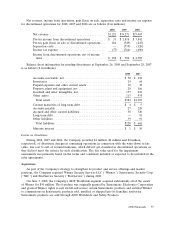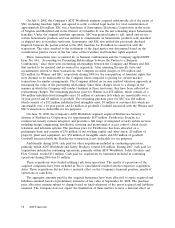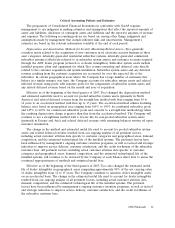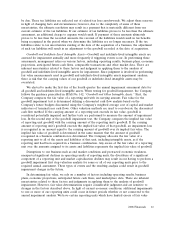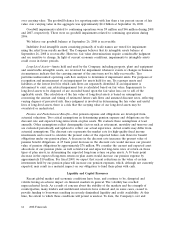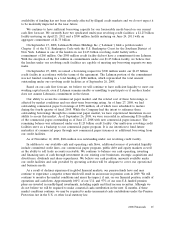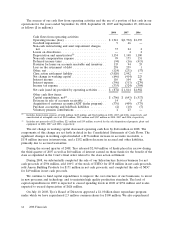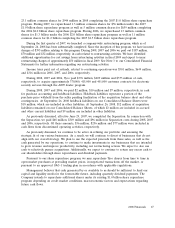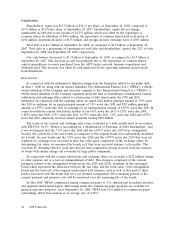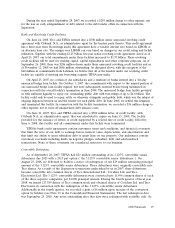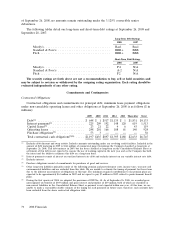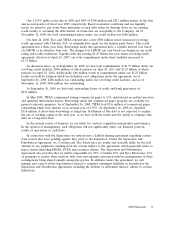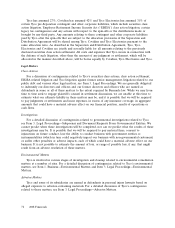ADT 2008 Annual Report Download - page 166
Download and view the complete annual report
Please find page 166 of the 2008 ADT annual report below. You can navigate through the pages in the report by either clicking on the pages listed below, or by using the keyword search tool below to find specific information within the annual report.be due. These tax liabilities are reflected net of related tax loss carryforwards. We adjust these reserves
in light of changing facts and circumstances; however, due to the complexity of some of these
uncertainties, the ultimate resolution may result in a payment that is materially different from our
current estimate of the tax liabilities. If our estimate of tax liabilities proves to be less than the ultimate
assessment, an additional charge to expense would result. If payment of these amounts ultimately
proves to be less than the recorded amounts, the reversal of the liabilities would result in tax benefits
being recognized in the period when we determine the liabilities are no longer necessary. If the tax
liabilities relate to tax uncertainties existing at the date of the acquisition of a business, the adjustment
of such tax liabilities will result in an adjustment to the goodwill recorded at the date of acquisition.
Goodwill and Indefinite-Lived Intangible Assets—Goodwill and indefinite-lived intangible assets are
assessed for impairment annually and more frequently if triggering events occur. In performing these
assessments, management relies on various factors, including operating results, business plans, economic
projections, anticipated future cash flows, comparable transactions and other market data. There are
inherent uncertainties related to these factors and judgment in applying them to the analysis of
goodwill and indefinite-lived intangible assets for impairment. Since judgment is involved in performing
fair value measurements used in goodwill and indefinite-lived intangible assets impairment analyses,
there is risk that the carrying values of our goodwill or indefinite-lived intangible assets may be
overstated.
We elected to make the first day of the fourth quarter the annual impairment assessment date for
all goodwill and indefinite-lived intangible assets. When testing for goodwill impairment, the Company
follows the guidance prescribed in SFAS No. 142, ‘‘Goodwill and Other Intangible Assets.’’ First, the
Company compares the fair value of a reporting unit with its carrying amount. Fair value for the
goodwill impairment test is determined utilizing a discounted cash flow analysis based on the
Company’s future budgets discounted using the Company’s weighted average cost of capital and market
indicators of terminal year cash flows. Other valuation methods are used to corroborate the discounted
cash flow method. If the carrying amount of a reporting unit exceeds its fair value, goodwill is
considered potentially impaired and further tests are performed to measure the amount of impairment
loss. In the second step of the goodwill impairment test, the Company compares the implied fair value
of reporting unit goodwill with the carrying amount of the reporting unit’s goodwill. If the carrying
amount of reporting unit’s goodwill exceeds the implied fair value of that goodwill, an impairment loss
is recognized in an amount equal to the carrying amount of goodwill over its implied fair value. The
implied fair value of goodwill is determined in the same manner that the amount of goodwill
recognized in a business combination is determined. The Company allocates the fair value of a
reporting unit to all of the assets and liabilities of that unit, including intangible assets, as if the
reporting unit had been acquired in a business combination. Any excess of the fair value of a reporting
unit over the amounts assigned to its assets and liabilities represents the implied fair value of goodwill.
Disruptions to our business such as end market conditions and protracted economic weakness,
unexpected significant declines in operating results of reporting units, the divestiture of a significant
component of a reporting unit and market capitalization declines may result in our having to perform a
goodwill impairment first step valuation analysis for some or all of our reporting units prior to the
required annual assessment. These types of events and the resulting analysis could result in goodwill
impairment charges in the future.
In determining fair value, we rely on a number of factors including operating results, business
plans, economic projections, anticipated future cash flows, and marketplace data. There are inherent
uncertainties related to these factors and judgments in applying them to the analysis of goodwill
impairment. However, fair value determinations require considerable judgment and are sensitive to
changes in the factors described above. In light of current economic conditions, additional impairments
to one or more of our reporting units could occur in future periods whether or not connected to the
annual impairment analysis. We have certain reporting units which have limited excess of fair value
2008 Financials 63






